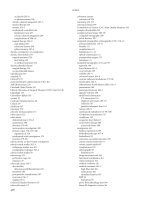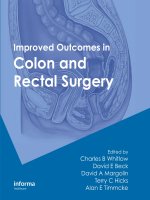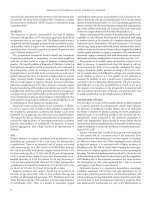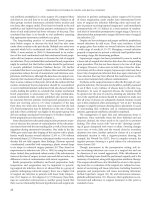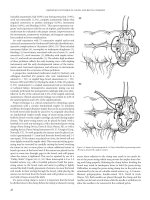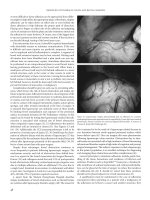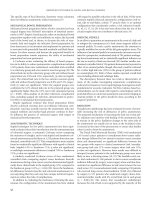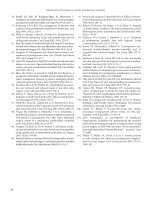Improved Outcomes in Colon and Rectal Surgery part 12 ppsx
Bạn đang xem bản rút gọn của tài liệu. Xem và tải ngay bản đầy đủ của tài liệu tại đây (818.28 KB, 10 trang )
improved outcomes in colon and rectal surgery
Figure 11.3 Small Bowel Obstruction. Plain radiograph demonstrates dilated
loops of small bowel with absence of colonic gas indicating a complete/high grade
small bowel obstruction. There is air in the right inguinal canal. This patient had
a surgery proven incarcerated right inguinal hernia.
Figure 11.4 Large Bowel Obstruction. Supine radiograph demonstrates dilated
colon as well as dilated small bowel in the right lower quadrant, indicating a large
bowel obstruction with incompetent ileocecal valve.
levels, and absence of colonic gas indicate a complete/high grade
small bowel obstruction. SBO can be simple (blood supply not
impaired) or strangulating (blood supply impaired). Most stran-
gulating obstructions are closed-loop obstructions (blocked at
both ends), and this occurs typically with incarcerated hernias
(Figure 11.3) and volvulus.(4) Plain films are not able to reliably
differentiate simple from strangulating obstruction. However,
extensive mucosal thickening or edema, portal venous gas, or
a closed loop obstruction indicates high risk for strangulating
obstruction.(5)
Large bowel obstructions (LBO) occur commonly in the sigmoid
colon, where stool is more formed and the colon is narrower. Air fluid
levels distal to the hepatic flexure are strong evidence of obstruction
unless the patient has had an enema. When the ileocecal valve is com-
petent, the small bowel usually contains little gas. When the ileocecal
valve is incompetent (Figure 11.4), gaseous distention of the small
bowel is often present as the colon decompresses into the ileum.(6)
Toxic Megacolon
Toxic megacolon is a manifestation of sever colitis with absent
peristalsis, and extreme dilation of all or a portions of the colon.
A markedly dilated (>6 cm) colon with “thumbprinting” (thick-
ened mucosal folds projecting into the lumen caused by bowel
wall edema) is concerning for toxic megacolon (Figure 11.5).
Figure 11.5 Toxic Megacolon. Plain radiograph demonstrates a markedly dilated
transverse colon with “thumbprinting” (thickened folds projecting into the lumen
caused by bowel wall edema – see arrows) in a patient with ulcerative colitis and
toxic megacolon.
When the cecum exceeds 10 cm in diameter, it is at risk for
perforation. Ulcerative colitis is the most common cause of toxic
megacolon and other causes include: Crohn’s colitis and infec-
tious colitis. Barium enema is contraindicated because of the per-
foration risk.(4)
Sigmoid and Cecal Volvulus
Sigmoid volvulus is a closed loop obstruction that occurs most
common in the elderly. On plain films, the sigmoid colon appears
as a large gas-filled loop without haustral makings, arising from
the pelvis and extending high into the abdomen. The three white
limitations of colorectal imaging studies
Figure 11.6 Sigmoid Volvulus. Radiograph of the abdomen demonstrates the
characteristic massive dilation of the sigmoid colon arising from the pelvis and
extending to the right diaphragm. Three lines representing the twisted walls of the
sigmoid colon converge in the left lower quadrant.
Figure 11.7 Cecal Volvulus. Abdominal radiograph demonstrates a massively
dilated cecum folded over into the left upper quadrant with distended small bowel.
Figure 11.8 Limitations of Plain Films. CT of the same patient in Figure 11.I-
B-2 shows the cause of the large bowel obstruction is an annular constricting
sigmoid carcinoma. A dilated loop of small bowel is seen adjacent to the sigmoid
colon.
lines formed by the lateral walls of the loop and the summation
of the two opposed medial walls of the loop usually converge
inferiorly into the left iliac fossa (Figure 11.6). Cecal volvulus
on plain films is characterized by a massively dilated cecum
folded over into the left upper quadrant (Figure 11.7), usually
with distended small bowel.(6) Confirmation of a volvulus can
be obtained with CT or contrast enema (See CT scan [sigmoid
volvulus] and fluoroscopy [water soluble enemas]).
Benefits and Limitations of Acute Abdominal Series (AAS)
Plain Films
AAS are relatively inexpensive, and can be performed with porta-
ble equipment. However, AAS is insensitive, results are often not
specific, and other imaging modalities (e.g. CT) (Figure 11.8) are
often needed for definitive evaluation.(2–5)
COMPUTED TOMOGRAPHY (CT SCAN)
Unenhanced Multidector Computed
Tomography vs. Plain Films
Unenhanced spiral/helical Multidetector Computed Tomography
(MDCT) is an accurate technique in the evaluation of patients
with traumatic or nontraumatic abdominal pain and should be
considered as an alternative to plain films as the initial imaging
modality.(7–10) MDCT is more expensive and exposes the patient
to more radiation. However, given the poor sensitivity of plain
films; the radiation, time, and money spent pursuing a plain film
examination in all patients may be unnecessary.(10) Additionally,
MDCT provides more information to the surgeon for preopera-
tive planning. With the advent of the new 16, 32, and 64 MDCT
fast speed scanners, a high quality MDCT can be obtained almost
as rapidly as a plain film, but it is not portable.
1
improved outcomes in colon and rectal surgery
Contrast Enhanced Multidector Computed Tomography
If the patient has no contraindications to oral and IV contrast
(allergy, renal insufficiency), a contrast enhanced MDCT has
been shown to be sensitive in diagnosing patients with bowel
obstruction; as well as inflammatory, infectious, and neoplas-
tic processes.(9, 11–27) Low osmolar, “nonionic,” iodine-based
agents are more expensive than the older “ionic” contrast agents,
but provide a decreased risk of adverse reactions and renal dam-
age. If the patient has a simple allergy to IV contrast, such as
hives; a low osmolar, “nonionic” contrast should be used and the
patient can be premedicated with steroids and diphenhydramine
(Table 11.1). Prior anaphylaxis to IV contrast is a complete con-
traindication. Orally administered water soluble contrast and rec-
tal contrast add significant additional diagnostic information as
accurate interpretation requires optimal opacification of the GI
tract. However, to allow appropriate intraluminal distention with
contrast, the patient has to drink contrast 1–2 hours before the
CT scan can be performed. Diluted 2% barium mixture can also
be used for oral contrast, but if bowel perforation is suspected,
barium should be avoided as it can cause severe peritonitis.
Pneumatosis, Pneumoperitoneum, and Bowel Trauma
Pneumatosis (air in the bowel wall due to ischemia) and pneu-
moperitoneum from a traumatic or nontraumatic perforated
This section will focus on abdominal trauma to the bowel and mesentery that a colorectal surgeon may encounter. Trauma to the other intraabdominal organs (e.g.
liver, spleen, bones) will be omitted.
Figure 11.9 Pneumoperitoneum. When viewed on lung windows, free air can be
seen in the subdiaphragmatic area, along the anterior peritoneal surfaces of the liver.
Figure 11.10 CT Signs of Bowel Injury. MDCT axial section demonstrates
pneumoperitoneum, free intraabdominal fluid, an air fluid level, and extravasation
of oral contrast material in a patient with blunt abdominal trauma.
Table 11.1 Premedication for Contrast Allergy.
Oral Premedication for Contrast Allergy
Prednisone 50 mg orally at 13, 6, and 1 hour prior to IV contrast
administration
Diphenhydramine 50 mg orally 1 hour prior to IV contrast administration.
Emergency Stat Premedication for Contrast Allergy
30 minutes prior to IV contrast: Hydrocortisone 100 mg IV or Solucortef
200 mg IV and Diphenhydramine 50 mg IV.
abdominal viscus, can be identified on MDCT when examined
on “lung windows” (window level – 400 to -600 H; window width
1000 to 2000 H). Pneumoperitoneum can be seen in the subdia-
phragmatic area, along the anterior surfaces of the liver (Figure
11.9). The accuracy of CT in the diagnosis of blunt abdominal
trauma has been reported to be as high as 97%.(28–33) The
routine use of oral contrast in CT examination of abdomi-
nal trauma is controversial. Oral contrast material can aid in
the identification of bowel loops, and differentiation of bowel
from hematoma or hemorrhage. Disadvantages of oral contrast
include risk of aspiration, and additional time requirements
which may delay diagnosis.(33–35) Posttraumatic abdomi-
nal CT examinations should be performed using IV contrast,
which maximizes the difference between contrast-enhancing
bowel and nonenhancing hematomas.(36) CT signs of bowel
and mesenteric injury include: (1) pneumoperitoneum; (2)
extravasation of oral contrast material; (3) free intraabdominal
fluid (Figure 11.10); (4) intramural hemorrhage, manifested as
luminal narrowing with thickened and/or discontinuous bowel
Table 11.2 Bowel wall thickening.
Benign Neoplastic
Circumferential thickening Eccentric thickening
Symmetric thickening Asymmetric thickening
Thickening <1–2 cm Thickening >2 cm
Segmental or diffuse involvement Focal soft tissue mass
Mesenteric fat thickening
Long segments of involvement
Abrupt transition and lobulated
contour
Short segments of involvement
except lymphoma
Wall is homogeneous soft tissue
density
Spiculated outer contour
Stratified enhancement “double halo”
or “target” appearance
Luminal narrowing, adenopathy, or
liver metastasis.
11
limitations of colorectal imaging studies
wall; (5) intense enhancement or high-attenuation clot (senti-
nel clot) adjacent to the involved bowel (30, 37–48).
Bowel Wall Thickening
When fully distended the bowel wall is 1–2 mm in thickness, and
the collapsed bowel wall should not exceed 3–4 mm. MDCT can
often differentiate benign from malignant wall thickening (Table
11.2). Benign, pathologic wall thickening (Figure 11.11) is seen
in infectious, inflammatory, and ischemic processes; usually does
not exceed 1–2 cm; is homogenous in attenuation; and is circum-
ferential, symmetric, and segmental in distribution.(49) A strati-
fied enhancement pattern in a thickened segment of bowel wall
is used to exclude malignant conditions. Such a pattern may have
a “double halo” or “target” appearance of the intestine in cross
section which is caused by inflammation, edema, and hyperemia
(Figure 11.12). Neoplastic wall thickening is thicker (2–3 cm),
asymmetric, nodular, lobulated, or spiculated in contour and
tends to narrow the intestinal lumen (Figure 11.13). The extent
or length of bowel wall involvement aids in narrowing the differ-
ential diagnosis. With few exceptions (mainly lymphoma), long
segments of involvement indicate a benign condition. When the
perienteric fat adjacent to a thickened bowel segment is normal,
Figure 11.11 Benign, Pathologic Wall Thickening. MDCT coronal reformatted
image demonstrates colonic wall thickening (<1 cm) that is homogenous, circum-
ferential, symmetric, and segmental in distribution. The long segment of involvement
suggests a benign condition.
Figure 11.12 “Double Halo” or “Target” Sign. MDCT axial image of the same
patient in Figure 11.II-D-1, demonstrates a stratified enhancement pattern in a
thickened segment of descending colon bowel wall.
Figure 11.13 Neoplastic Wall Thickening. MDCT axial image demonstrates
abnormal colon wall thickening (>3 cm) that is asymmetric, nodular, and
lobulated in contour with narrowing of the intestinal lumen. The combination
of a paucity of pericolonic fat stranding with the short segment of involvement is
worrisome for malignancy. Surgery confirmed adenocarcinoma.
Table 11.3 Ulcerative colitis versus Crohn Colitis.
Ulcerative Colitis
Crohn Colitis
Circumferential disease
Eccentric disease
Continuous disease
Skip lesions
Predominantly left-sided
Predominantly right-sided
Rectum usually involved
Rectum normal in 50%
Confluent shallow ulcers
Confluent deep ulcers
No aphthous ulcers
Aphthous ulcer early
Collar button ulcers
Transverse and longitudinal
ulcers
Terminal ileum usually normal
Terminal ileum usually
diseased
Terminal ileum patulous in backwash ileitis
Terminal ileum narrowed
No pseudodiverticula
Pseudodiverticula
Inflammatory polyps and pseudopolyps
No polyps or pseudopolyps
No fistulas
Fistulas common
High risk of cancer
Low risk of cancer
Risk of toxic megacolon
No toxic megacolon
1
improved outcomes in colon and rectal surgery
an acute inflammatory condition is less likely. Fat stranding that
is disproportionately more severe than the degree of wall thick-
ening suggests an infectious or inflammatory process.(50)
Inflammatory Bowel Disease (IBD)
Benign, circumferential thickening of the bowel wall is a hallmark
of Crohn’s Disease (Table 11.3). Wall thickening (Figure 11.14)
can result in strictures that narrow the bowel lumen in advanced
disease.(51–52) CT is excellent in documenting the extralumi-
nal manifestations of the disease such as the “comb sign” (Figure
11.15), which is produced by hyperemic thickening of the vasa
recta due to active disease. The swollen blood vessels produce an
appearance like the teeth of a comb extending from the thickened
bowel wall into the mesenteric fat.(53) “Skip areas” of normal
bowel intervened between diseased segments are characteristic.
Mesenteric abscesses are characteristic and may can contain fluid,
air, or contrast material (54–57) (Figure 11.16). Crohn’s Colitis is
characterized by transmural inflammation that usually affects the
terminal ileum (80%) and proximal colon (50%).(51–52) Bowel
wall thickening in Crohn’s colitis is typically 10 to 20 mm com-
pared with the 7 to 8 mm for Ulcerative Colitis (UC). With Crohn’s
colitis (Figure 11.15), the outer wall is irregular, whereas with UC
the outer wall is smooth.(58) Acute active disease shows layering
of the colon wall (“target and halo” signs), whereas chronic dis-
ease with fibrosis shows homogeneous enhancement of the colon
wall. Fibrous and fat proliferation in the mesentery (“creeping
Figure 11.14 Crohn’s Disease. Axial MDCT demonstrates circumferential wall
thickening of the terminal ileum that results in narrowing of the bowel lumen
and formation of a stricture.
Figure 11.15 “Comb Sign”. Swollen blood vessels produce an appearance like the
teeth of a comb extending from the thickened bowel wall into the mesenteric fat.
Note the irregular outer wall of the cecum indicating Crohn’s colitis.
Figure 11.16 Crohn’s Abscess. Axial MDCT image demonstrates extraluminal
abscess in this patient with Crohn’s disease/colitis.
Figure 11.17 Ulcerative Colitis. Coronal reformatted CT image of the abdomen
and pelvis shows wall thickening and marked irregularity of the remaining mucosa
in the ascending and descending colon (arrows).
1
limitations of colorectal imaging studies
fat”) separates bowel loops with extensive fat-containing fibrous
strands. Sinus tracts between bowel loops, enterocutaneous fis-
tulas, and enterovesicular fistulas are also characteristic findings.
Ulcerative Colitis (UC) is characterized by inflammation and dif-
fuse ulceration of the colon mucosa (Figure 11.17). The disease
starts in the rectum and extends proximally to involve part or
the entire colon. Wall thickening with luminal narrowing and the
inflammatory pseudopolyps, that result from mucosal ulceration,
are sometimes seen on CT (Figure 11.18). Narrowing of the rectal
lumen with thickening of the rectal wall and widening of the pre-
sacral space are often seen (51–53, 58). Similar to Crohn’s disease,
mesenteric adenopathy can be seen, but it is not specific for IBD.
Other Colitides
Psuedomembranous colitis results from overgrowth of Clostri-
dium difficile and its enterotoxin, as a complication of antibiotic
therapy. A pancolitis with irregular wall thickening (up to 30 mm)
Figure 11.18 Ulcerative Colitis. Coronal reformatted CT image of the abdomen
and pelvis shows pseudopolyps (arrow) that extend into the lumen of the
transverse colon.
Figure 11.19 Psuedomembranous Colitis. Axial MDCT demonstrates pancolitis
with irregular wall thickening and submucoal edema resulting in a characteristic
“accordion pattern” of disease.
Figure 11.20 Typhilitis. MDCT axial image demonstrates marked wall thickening,
low-density edema within the cecal wall, and pericecal fluid and inflammation in
a patient with HIV. The wall thickening and inflammation extended from the
cecum to the hepatic flexure.
Figure 11.21 Radiation Colitis. Axial MDCT image demonstrates mucosal
thickening with prominent stranding in the expanded pericolic fat confined to
the radiation port distribution. A lymphomatous mass is noted adjacent to the
radiation colitis (large arrow).
1
improved outcomes in colon and rectal surgery
and submucoal edema results in the “accordion pattern” of dis-
ease that is characteristic.(58) The edema and thickening of the
colon may be greater than that seen with other colitides, and a
pancolitis suggests pseudomembranous colitis (Figure 11.19).
Typhilitis or neutropenic colitis refers to a potentially fatal infection
of the cecum and ascending colon in patients who are immuno-
compromised. CT is the study of choice for making the diagno-
sis. Typhilitis is characterized by marked wall thickening (10–30
mm), low-density edema in the cecal wall, pericecal fluid, and
inflammation (Figure 11.20), which may be confused with the
reactive changes of appendicitis.(58–59) The length of the cecum
and right colon involved is generally much greater with typhlitis,
and the thickening is more asymmetric in appendicitis.(60) The
presence of known risk factors favors the diagnosis of typhilitis.
Ischemic colitis features include benign, pathologic wall thicken-
ing in a vascular distribution watershed segment of colon, usually
at the splenic flexure (Figure 11.12). Radiation colitis in the acute
phase demonstrates mild wall thickening and pericolic fat strand-
ing confined to the radiation port area. Chronic radiation injury
6 to 24 months after treatment appears as mucosal thickening with
prominent stranding in expanded pericolic fat (Figure 11.21).
Infectious colitis differentiation is based on clinical findings
because CT findings are nonspecific. Infectious terminal ileitis
is usually caused by Yersinia, Tuberculosis, Campylobacter, or
Salmonella organisms.(61) The diagnosis is made clinically with
stool cultures. CT features are benign wall thickening of the ter-
minal ileum and cecum, and moderate or marked enlargement
of the mesenteric lymph nodes in the right lower quadrant.
(62)
Although a Meckel’s diverticulum occurs at some distance
(60–100 cm) from the cecum, it may cause complications such as
inflammation, whose differential diagnosis includes appendicitis
and IBD.(63) The CT diagnosis of an inflamed Meckel’s diver-
ticulum relies on the identification of a blind-ending,
tubular, or
round pouch-like structure in the right lower quadrant
attached
to the small intestine with surrounding inflammation. Small
intestinal obstruction and
visualization of a normal appendix aid
in diagnosis.(63–64)
Diverticulitis
Acute diverticulitis is characterized by benign wall thickening,
hyperemic contrast enhancement, inflammatory pericolic fat
stranding, and diverticula in the involved segment (Figure 11.22).
Perforation or abscess may form, and CT is better suited to dem-
onstrate extraluminal disease than barium enema (Figure 11.23).
Sinus tracts and fistulas may extend to adjacent organs or the skin
and are represented by linear fluid or air collections. Air in the
bladder suggests a colovesicular fistula, unless the patient has had
Figure 11.22 Diverticulitis. Axial MDCT demonstrates benign wall thickening,
hyperemic contrast enhancement, and inflammatory change that extend into the
pericolic fat, with diverticula in the involved segment.
Figure 11.24 Colon Cancer. Axial MDCT demonstrates a large colonic mass in
the descending colon that narrows the lumen. CT cannot differentiate tumor
extension through the wall from pericolonic edema or desmoplastic reaction.
Figure 11.23 Perforated Diverticulitis. Axial MDCT image demonstrates colon
wall thickening and extravasation of oral contrast (small arrows), as well as free
peritoneal air anteriorly (large arrow).
1
limitations of colorectal imaging studies
bladder catheterization. Obstruction of the colon or urinary tract
from the inflammatory process can be seen on CT. Diverticulitis
of the right colon may be confused with acute appendicitis or
IBD. Visualization of a normal appendix
or inflammatory changes
involving the ascending colon distal to the ileocecal valve favor
the diagnosis of
diverticulitis over appendicitis.(58) The extrin-
sic inflammation from a tubo-ovarian abscess may cause
serosal
edema and mural thickening of the cecum or sigmoid colon wall.
Recognizing that the inflammation is centered in the adnexa and
appropriate distention of the colon with oral and rectal contrast
agents assist in making the correct diagnosis.(65–66)
Colorectal Cancer
Detection and Differentiation from Diverticulitis
The CT appearance of diverticulitis overlaps that of colon cancer,
as bowel wall thickening and pericolonic fat stranding occur in
both. Fluid in the sigmoid mesentery and engorgement of mes-
enteric vessels favors diverticulitis (Table 11.2). Enlarged lymph
nodes, asymmetric wall thickening, and the presence of an intralu-
minal mass (Figure 11.24) favors cancer.(67–73) Prior recent films
showing no colonic wall thickening can aid in diagnosis. A biopsy
may be required in equivocal cases.
Colorectal Cancer Staging
Preoperative CT for staging colorectal cancer is performed to
detect invasion of adjacent organs, enlargement of local nodes,
or evidence of distant metastases. The Tumor, Nodes, Metastasis
(TNM) and Dukes classification are both used for preoperative
staging (Table 11.4). Squamous cell carcinoma can occur in the
anal canal, and it does not have any discriminating imaging fea-
tures from adenocarcinoma. The primary adenocarcinoma may
be seen as a polyp larger than 1 cm, or a soft-tissue cancer mass
that narrows the lumen of the colon.(74) Flat lesions appear as
focal, lobulated thickening of the bowel wall (>3 mm). “Apple
core” lesions demonstrate irregular bulky circumferential wall
thickening with marked and irregular narrowing of the bowel
lumen.(74–75) Adequate luminal distention is essential, and may
be achieved with oral and rectal water soluble contrast or water as
a negative contrast agent.(76–77) The accuracy of CT in preoper-
ative staging varies from 48% to 77%, and this variability depends
on the actual stage of the cancer.(78–82) The accuracy of CT stag-
ing ranges from 17% for early lesions (Dukes stage B) to 81% for
advanced lesions (Dukes stage D) (75, 80, 83). Inaccuracies arise
from the inability to distinguish tumor from peritumoral desmo-
plastic reaction or edema, and the inability to detect microscopic
extramural tumor extension (Figure 11.24). A major advantage
of CT is the ability to demonstrate the local extent of tumor and
involvement of adjacent organs, such as the bladder, vagina, peri-
toneum, and abdominal or pelvic musculature.(84) Also, MDCT
can reliably detect enlarged lymph nodes for staging of colorectal
cancer.(83) Although the presence of lymph nodes larger than
1–1.5 cm in short-axis diameter is considered pathologic, not all
enlarged nodes contain tumor. Conversely, normal-sized nodes
may have microscopic tumor involvement.(80) Another factor
that poses problems in staging is ischemic bowel associated with
an obstructing colon cancer.(85–87) Detecting ischemic change
proximal to colonic carcinoma is important because 25% of cases
Table 11.4 TNM compared to modified Dukes staging for
colorectal carcinoma.
TNM Stage Modified Dukes Stage
I: Submucosa T1, Muscularis, T2 N0M0
A: Limited to wall mucosa or
submucosa
II: Muscularis T3, Perirectal T4 N0M0
B: Extension into or through
serosa
IIIA: T1–4N1M0 IIIB: T1–4N2–3M0
C: Cancer that extends to lymph
nodes
IV: T1–4 N1–3 M1
D: Distant Metastasis
Figure 11.25 Colon cancer liver metastasis. MDCT performed with IV contrast
material during the portal vein phase of enhancement shows heterogeneous, ring-
enhancing metastases that are hypodense to the liver.
Figure 11.26 Mucinous Adenocarcinoma Metastatic Disease. MDCT axial
image shows necrosis and calcification of meatastatic mucinous adenocarcinoma
to the liver.
1
improved outcomes in colon and rectal surgery
with proximal ischemic colitis have been reported to cause post-
operative complications such as suture-line disruption.(86–89)
Also, an ischemic segment in colonic carcinoma may give a false
radiologic impression regarding tumor length or depth of tumor
invasion.(85) Ischemia can develop at sites remote from the
obstructing cancer, such as the terminal ileum, mimicking syn-
chronous lesions.(85, 89–93) CT can usually distinguish an isch-
emic segment from a tumoral segment in approximately 75% of
the cases by applying the criteria for benign (ischemic) bowel wall
thickening, and the “target” or “double halo” sign is the most spe-
cific sign.(88–93) This finding must be interpreted with caution,
as signet ring cell adenocarcinoma can have low-density mural
thickening.
Colorectal Cancer Metastasis
The liver is the predominant organ to be involved with metas-
tases from colorectal cancer, and MDCT has an established role
in detection. Hepatic metastases are supplied by the hepatic
artery, and two thirds of the liver is supplied by the portal vein.
MDCT (performed with IV contrast material during the portal
vein phase of enhancement, 60–70 sec after the start of the bolus)
typically shows heterogeneous, ring-enhancing metastases that
are hypodense to the liver (Figure 11.25). Images obtained after
a longer delay may not reveal evidence of disease because lesions
become isodense to the liver.(94–95) Small lesions (<1 cm) do
not have adequate enhancing properties to be differentiated and
are named indeterminate lesions. Necrosis and calcification of
metastatic mucinous adenocarcinoma to the liver can be seen on
MDCT (Figure 11.26). CT can detect intraperitoneal metastases,
which appear as thickening of the peritoneal surfaces or perito-
neal nodules (Figure 11.27), but microscopic seeding will not be
detected. Careful attention to the peritoneal surfaces and omen-
tum is needed in the setting of unexplained ascites to identify
peritoneal metastases.
CT arterial portography is a very sensitive technique for detec-
tion of liver metastasis. This procedure requires fluoroscopic/
angiographic guided catheter placement in the superior mes-
enteric artery using the Seldinger technique through the femo-
ral artery. Intraarterial injection of contrast material results in
intense portal vein enhancement of the normal liver. Both meta-
static disease and benign perfusion abnormalities manifest as fill-
ing defects on CT portography, and therefore the sensitivity of
this test is less than perfect. Likewise, intraarterial hepatic artery
injection (hepatic arteriography) can aid in identifying liver
metastasis as they will enhance brightly. Some studies have sug-
gested that combined CT arterial portography and CT hepatic
arteriography significantly improved the detect ability of hepatic
metastases.(96) However, these unified CT-angiography sys-
tems are not widely available and require an invasive procedure.
Furthermore, a recent study (97) showed that the use of portal
venous phase enhanced MDCT as the only preoperative imag-
ing technique in the assessment of colorectal cancer metastases
allowed accurate preoperative staging (sensitivity, 85.1%; positive
predictive value, 96.1%).
Colorectal Cancer Recurrence
Local recurrent tumor usually appears as a soft-tissue mass in or
near the surgical site. Due to the often largely extrinsic component
of local recurrence, CT is better than colonoscopy at demonstrat-
ing the early, mass like tumor recurrence.(98, 99) This appearance
can mimic postoperative fibrosis, although fibrosis usually appears
more linear without a discrete mass. Following abdominoperineal
resection, it is common to see soft tissue density within the pre-
sacral space. When this material remains plaque-like, fibrosis is
likely. Often, distinction between postoperative fibrosis and recur-
rent tumor is not possible unless serial scans are obtained. CT
findings clearly indicative of recurrent malignant disease include
enlargement of a soft-tissue mass over time, enlarging lymphade-
nopathy, and invasion of contiguous structures.
CT performed with intravenous contrast material is the imaging
modality of choice for detection of recurrent tumor within the liver.
CT has been shown to be more helpful in diagnosis of recurrent
Figure 11.27 Colon Cancer Peritoneal Metastasis. Axial MDCT demonstrates
thickening of the peritoneal surfaces, ascities, and two large peritoneal nodules in
a patient with colon cancer.
Figure 11.28 Anastomotic Leak. Axial MDCT demonstrates high density ascites
representing extravasted oral contrast in this patient status postterminal ileum
resection and ileocolic anastomosis. Pneumoperitoneum is also seen.
1
limitations of colorectal imaging studies
hepatic metastases than laboratory studies (liver function tests, mea-
surement of carcinoembryonic antigen level).(80, 100) The impor-
tance of abdominal CT is reflected in the surveillance guidelines
proposed by the American Society of Clinical Oncology.(101) The
guidelines recommend annual CT of the abdomen for 3 years after
primary therapy for patients who are at high risk of recurrence.
Postoperative Complications
MDCT is often used to diagnose postoperative complications
such as abscess, anastomotic leak, fistula, small bowel obstruc-
tion, ileus, and pulmonary embolus (small bowel obstruction
and ileus will be covered later). Before postoperative day five, it
is difficult to differentiate normal postoperative intraperitoneal
free air and fluid from fluid or air from an anastomotic leak or
abscess.(102) Findings suggestive of an anastomotic leak include
an inappropriate volume of free air or fluid in the abdomen. The
presence of extraluminal oral contrast (Figure 11.28) confirms an
anastomotic leak.(102)
CT is the most accurate imaging test for diagnosing abscess
formation in the postsurgical patient.(103) The combination of
water soluble oral contrast and an intravenous contrast agent is
essential in differentiating between a fluid-filled bowel loop and
an abscess. The CT appearance of an abscess is variable depend-
ing on its age and location. Early abscess appears as a mass
with an attenuation value near that of soft tissue. As the abscess
matures, it undergoes necrosis with a central region of near-water
attenuation surrounded by a high attenuation rim that usually
enhances.(104) Approximately one third of abscesses contain
variable amounts of gas (Figure 11.29).(104–108) Postoperative
packing materials used for hemostasis, such as oxidized cellulose
and gelatin bioabsorbable sponge, can mimic a gas-containing
abscess. Findings that may help differentiate are: linear arrange-
ment of tightly packed gas bubbles, an unchanged appearance on
subsequent examinations, and lack of either a gas-fluid level or an
enhancing wall.(109, 110) A low-density mass containing a high
density object suggests a foreign body abscess caused by a retained
surgical sponge (gossypiboma).(111) Although CT findings are
highly suggestive of abscess, they are not specific. Other masses
that can have a central low attenuation include a cyst, pseudo-
cyst, hematoma, urinoma, lymphocele, biloma, loculated ascites,
thrombosed aneurysm, and necrotic neoplasm. Because a specific
diagnosis of abscess based on CT findings alone is not possible,
correlation with clinical history is important. Percutaneous nee-
dle aspiration may be necessary to make a definitive diagnosis
(See interventional radiology).
Fistula formation between the bowel and other organs such as
the bladder, vagina, or skin can form as complications of surgi-
cal or radiation therapy. Fistula can be identified with IV or oral
contrast and are demonstrated as extension of contrast from
one organ to the other. Oral and IV contrast should not be used
simultaneously for a suspected bowel/bladder fistula because
contrast in the bladder could be from renal excretion or a bowel/
bladder fistula.
Pulmonary embolism can occur in cancer and postoperative
patients. Since the introduction of spiral MDCT, CT angiography
Figure 11.29 Postoperative Abscess. Axial MDCT demonstrates a large air
fluid collection (abscess) in the operative field, in this patient status posttotal
colectomy and ileorectal anastomosis. The anastomotic suture line can also be
seen. The large amount of gas in the abscess suggests communication with the
gastrointestinal tract.
Figure 11.30 A and 11.30B Acute Appendicitis. Axial MDCT demonstrates
an obstructing calcified appendicolith with an abnormally dilated, enhancing
appendix surrounded by inflammatory fat stranding.
(a)
(b)
